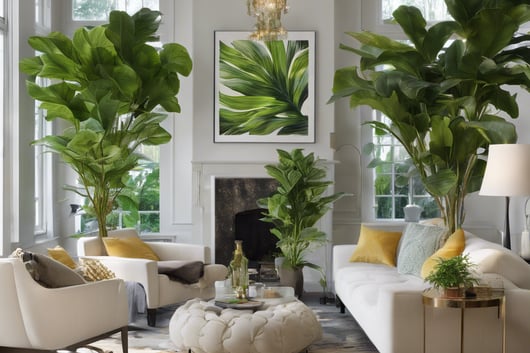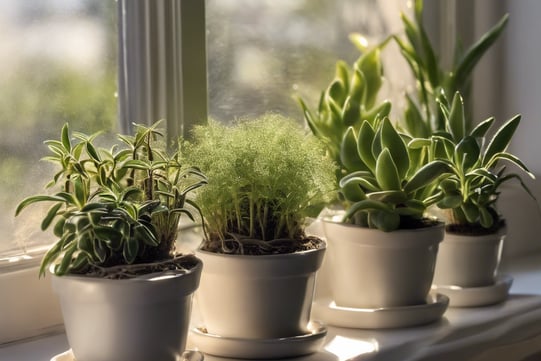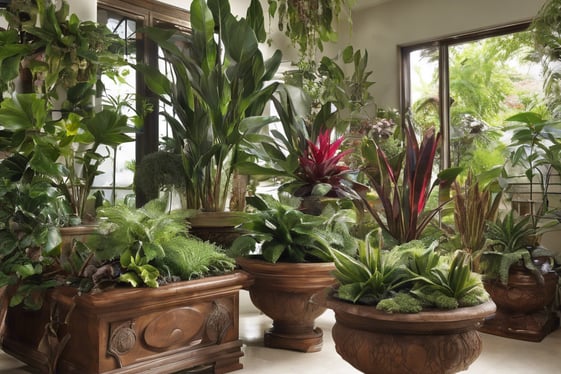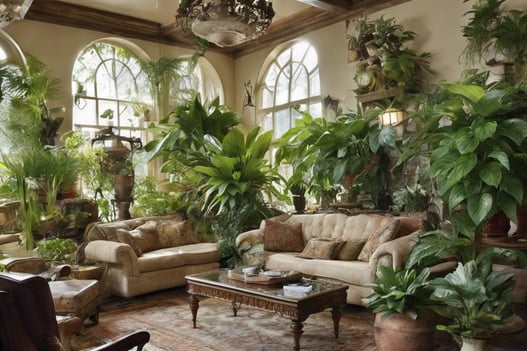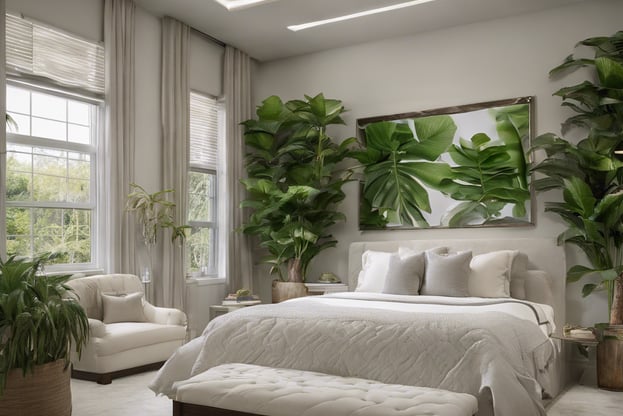Bring the Outdoors In
Indoor plants can help brighten up your space and provide an inviting surrounding to welcome your family members and guests.
11/8/20246 min read
Easy Indoor Plants Brighten Up Your Space: A Guide to Lively Home Decor
Indoor plants are an effortless way to add life and color to any space. They not only improve aesthetic appeal but also contribute to a healthier environment by purifying the air. Choosing the right plants can make all the difference, especially for beginners or those with little time for maintenance.
Some of the easiest indoor plants to care for include the resilient snake plant, the adaptable pothos, and the forgiving spider plant. These species thrive in various light conditions and require minimal watering, making them perfect for busy individuals or those new to plant care. Their robust nature ensures they remain vibrant with minimal effort.
Incorporating indoor plants into your home or workspace can also boost your mood and increase productivity. A touch of greenery can transform a dull corner into a lively focal point, inspiring creativity and promoting a sense of calm. With such benefits, it's easy to see why more people are turning to these simple yet effective natural enhancements.
Benefits of Indoor Plants
Indoor plants offer numerous benefits, including enhancing air quality, boosting psychological well-being, and adding aesthetic value to indoor spaces. These advantages make indoor plants a valuable addition to any home or office environment.
Air Quality Improvement
Indoor plants can significantly improve air quality by absorbing pollutants and releasing oxygen. Many common houseplants, such as the snake plant and peace lily, effectively remove toxins like formaldehyde and benzene from the air.
Plants' natural processes can increase humidity levels, reducing the likelihood of respiratory issues. In addition to purifying the air, they can help reduce dust levels by trapping airborne particles on their leaves. This natural filtration system can make the indoor environment healthier and more comfortable for occupants.
Psychological Effects
Being around indoor plants can enhance psychological well-being through stress reduction and improved mood. Studies have shown that exposure to greenery can lead to lower cortisol levels, which are associated with stress.
Moreover, the presence of plants can promote relaxation and concentration, making them beneficial for productivity in workspaces. The act of caring for plants itself can be therapeutic, offering a sense of purpose and a calming routine. This connection with nature, even indoors, can lead to a more positive and peaceful mindset.
Aesthetic Appeal
Indoor plants add an aesthetic appeal that can transform any environment. Their diverse colors, shapes, and sizes provide versatile decorating options, allowing for creativity and personalization.
Plants can serve as focal points or subtle enhancements to interior design, offering a natural contrast to artificial surroundings. Incorporating plants into decor not only beautifies a space but also creates a welcoming and lively atmosphere. This visual enhancement can make indoor areas more inviting and enjoyable for residents and guests alike.
Selecting the Right Plants
Choosing suitable plants for indoor spaces involves considering light requirements, the presence of pets, and ease of care for beginners. Careful selection helps ensure thriving, vibrant plant life in a home.
Low-Light Plants
For areas with limited natural light, there are several plants that thrive in these conditions. Pothos is a popular choice due to its tolerance of low-light and varied watering schedules. Snake Plant is another excellent option, known for its resilience and air-purifying qualities.
ZZ Plant can also survive in low-light environments. These plants do not need frequent watering, making them ideal for busy individuals. Peace Lily offers not only beauty but also the ability to improve air quality, and it can tolerate lower light levels while still producing blooms.
Pet-Friendly Options
When selecting plants for homes with pets, it is crucial to choose non-toxic varieties to prevent harm to animals. Spider Plant ranks as a pet-safe option and is known for its robust nature. Boston Ferns are another safe choice and add lush greenery to any space.
Calathea species are also pet-safe, with vibrant leaf patterns that enhance indoor decor. These plants prefer medium-indirect light and a humid environment. Bamboo Palm is another choice for pet owners, bringing a tropical feel without risking pet safety.
Hardy Varieties for Beginners
Beginners seeking easy-care indoor plants can opt for species like the Spider Plant, known for its resilience and ability to adapt to varied conditions. The Aloe Vera plant is another straightforward option, offering minimal care needs and potential health benefits.
Jade Plant requires infrequent watering and is tolerant of a range of light conditions. Philodendrons offer versatility and a wide array of leaf shapes, thriving with occasional watering and indirect light. Selecting such hardy varieties ensures success and boosts a beginner's confidence in plant care.
Plant Care Fundamentals
Choosing the right plants is important, but understanding basic care practices like watering, lighting, and fertilizing is crucial in keeping them healthy. Follow these essential guidelines to ensure indoor plants thrive.
Watering Basics
Proper watering is essential to prevent both dehydration and overwatering. Most indoor plants need water when the top inch of soil feels dry. It's important to adjust frequency according to plant type and environment. Signs of overwatering include yellowing leaves and root rot. Conversely, wilting and dry soil indicate the need for more water.
Use room temperature water, ensuring even distribution. Bottom watering, where a pot sits in a tray of water, can promote deeper root growth. Choose pots with drainage holes to prevent water from accumulating and damaging roots. A consistent schedule helps plants flourish and remain healthy.
Optimal Lighting
Light is a critical factor for plant growth. Most indoor plants prosper in bright, indirect sunlight, although some prefer low light conditions. Positioning plants near north or east-facing windows generally provides adequate light without causing leaf scorch. Rotating plants regularly ensures even light exposure, promoting balanced growth.
Understanding each plant's specific lighting needs is necessary. For instance, succulents and cacti thrive in direct sunlight, while ferns and peace lilies grow well in shaded areas. Consider using artificial grow lights during winter months or in dimly lit spaces to supplement natural sunlight. Adapting light conditions to meet plant requirements can significantly influence health and vitality.
Fertilizer Use
Fertilizing supports plant nutrition, facilitating robust growth. Choose a balanced, water-soluble fertilizer, typically applied in spring and summer. Avoid over-fertilization, which can cause leaf burn or salt buildup. Diluting fertilizer to half strength before application helps prevent damage, particularly for small or delicate plants.
Different plants require varying fertilizer types and frequencies. Leafy plants benefit from high nitrogen fertilizers, while flowering varieties thrive with phosphate-rich options. Regularly inspecting plants for nutrient deficiencies—a yellowing of older leaves may suggest a nitrogen shortage—can guide adjustment of fertilizer use. Proper fertilization fosters a lush and vibrant indoor garden.
Design Tips for Plant Layout
Arranging indoor plants effectively requires attention to how they are grouped, the planters selected, and the spaces they occupy. Thoughtful decisions enhance aesthetics and functionality.
Grouping Strategies
When clustering plants, size and variety are key elements. Combining plants of varying heights creates a dynamic visual effect. For instance, tall, leafy plants can be placed at the back, with medium-sized ones in the middle and short, trailing plants in the front.
Using color can unify a grouping. Green with occasional pops of color offers a cohesive theme. Placement in odd numbers, like threes or fives, often results in a more natural look.
Texture and light should also be considered. Group smooth-leafed plants with those having textured or patterned foliage to create contrast. Ensure plants with similar light needs are together to maintain healthy growth.
Choosing Planters
Selecting the right planter involves both function and style. Materials such as terracotta, ceramic, or plastic serve different purposes. Terracotta is porous and ideal for plants needing good drainage, while ceramic planters provide vibrant color options.
Size matters. Overly large planters can overwhelm, while small ones can stunt growth. Matching the pot size to the plant ensures ample growth space. Color and design of planters should complement the room's decor, adding to the aesthetic appeal without distracting from the plants themselves.
Surface finishes like matte, glossy, or textured can further enhance the visual impact. Each finish pairs differently with plant textures and surrounding décor.
Space Utilization
Optimal use of space involves creativity and practicality. Consider corner spaces or shelving for vertical interest. Hanging planters can optimize space, especially in smaller rooms where floor space is limited.
Utilize windowsills for plants needing lots of natural light. In larger rooms, consider plant stands or tiered displays to create layers. Allowing each plant room to breathe and be seen prevents the space from feeling cluttered.
Floating shelves and wall-mounted installations are great for a modern look, saving precious ground space and drawing the eye upward through the room. Balancing vertical and horizontal elements can add depth and interest to plant arrangements.
